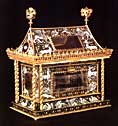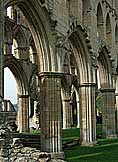What is Aesthetic Theology?
In
determining what Aesthetic Theology means to me, my starting point strangely is a mixture of my brain and
consciousness and how integrated I can make them. (Please see Aesthetics
& Consciousness for a greater explanation). On a surface level Aesthetic Theology is my relationship
with human experience of the awe of nature on the one hand and, on the other, of the best expressions of human
endeavour. In this I include not only such disciplines as art, architecture, music and writing but also science,
morality, even politics (e.g. the United Nations declaration on human rights) and, perhaps the most important,
meditation and theology. By ‘theology’ I mean the understanding and expression of our relationship with
God, with each other and with the rest of creation.
Can Theology, a wordy,
argumentative topic if ever there was one, be aesthetic? I think it not only can. It should be. By this I
mean not only should it be moral, spiritual (i.e. seeking to reach outside ourselves onto a different level of
existence), and integrated within society at a level where it can be fully understood, and indeed felt to be needed
by all. It should also be integrated within the science of historic critical analysis, mathematics, physics,
cosmology and consciousness studies. Only when it imports and integrates these disciplines (at whatever the cost to
its belief systems) can it be holistic, integrated within the universe, and therefore aesthetic.
First, how to define aesthetics. From one point of view it is impossible
because aesthetics is its own language. Even writing about it somehow demeans or limits it. You cannot, for example
define beauty, only the means by which it achieves is effects. It is like God. You cannot define God, only the
effects the Divine has. I believe God and aesthetics are interchangeable, or, more likely, the different sides of
the one coin. The creation of the universe remains the supreme manifestation of aesthetics, the creative urge to
produce an entity of great awe, majesty and beauty on the one hand but with incredible attention to the possibility
of interlocking and intercommunicating detail on the other. Moreover it is a creativity which is evolutionary, never
ending, the core principle of the universe which governs all. It is that indefinable component which unifies and
speaks through and to all things.
Thus aesthetics was, and is the primary means of
communication between the divine and his creation, preceding our primitive form of communication,
language, by some 13 billion years. After all, God was surely concerned about the universe and all that lived within
it before the advent of humanity and language. Whether we like it or not we remain but a very small drop in an
exceedingly large bucket in the grand scheme of creation. God spoke through the core of aesthetics, interactive and
moral creativity, intelligence, freewill and responsibility. The rest is up to his creation, including us!
This site is basically concerned with our aesthetic apprehension of Theology at all
levels, i.e. not only how pleasing, how perfect, how transcendent and how integrated with the rest of
creation are our responses to God or a divine creator, but how this reflects on us and in our every day lives. As a
working definition, for me aesthetic theology is that which pleases, promotes transcendency and which reaches into
the core of our being as something which is holistically right and true because it unifies everything within us, the
different parts of our brain and our consciousness, thereby making us not so much feel good as to reach a state of
recognition which originates or reaches outside our field of normal existence.I.e. it unites us with the
universe.
I feel, however, that aesthetic theology should go further, if only because of the complex
nature of the human consciousness and its need for integration and expression on both the intellectual and spiritual
level to reach its full potential. Consequently it needs to be not only all embracing and contain within itself a
spiritual and an ethical content, in that ethics itself is a non-material, transcendent understanding. Aesthetic
theology should also be an integrated discipline where historic and biblical truth and scientific investigation
integrate seamlessly with, indeed and sometimes condition, the spiritual sides of our nature.
Problems with the historic view of 'Aesthetic Theology'. Having researched many sites
using this terminology I am struck by a curious use of these two words. Here we have a defining adjective,
“aesthetic”, and a noun, “theology”. The first describes or qualifies the second, not vice versa. Too often have I
found sites in which “Aesthetic Theology” is used to describe that which is really a “Theology of Aesthetics”. That,
for me, is not the meaning of “Aesthetic Theology”. I consider it is theology which is the variable, as defined by
our understanding of the word 'aesthetic'. Thus we need to examine theology in the light of our understanding of
aesthetics in all its forms, including inherent truth and relevance to all. Too often aesthetics are used to bolster
a particular view of theology, such as the Virgin Birth or the redemption of the whole world on the Cross, rather
than starting with the whole panoply of aesthetics in all its manifestations, and then proceeding to derive a
theology from it.
Examples of Aesthetic Theology which induce, for me, such
transcendent reality would include the wonder of Nature through its changing seasons, the Christian Church’s
liturgical year based as it is on the rhythms of nature but which applies it to the human condition, art which seeks
to reproduce beauty linked to moral value, architecture (e.g. medieval cathedrals) which links humanity to God by
transporting the mind onto a higher plane of thought whilst creating wonder at the human ability to build in such a
way, the music of such as Bach, Byrd, Palestrina and Taverner which uses the very building blocks of all creation,
vibrations, to produce subtle harmonies and interplay of parts to express the human condition on an eternal score,
the simplicity of message of truly profound leaders of any religion the core of which is centred on love,
acceptance, meditation and evolution towards a transcendent state of existence.
Aesthetics,
not logic, the heart of creation. If we accept that this world is a closed entity, i.e. nothing
has been added to or subtracted from it since that first Big Bang, then Aesthetics are, in fact, at the very heart
of our being because they were there at the point of creation. According to Genesis one could say that creation came
into being out of a love of order, beauty and creation. In that ‘man’ was created ‘in the likeness
of God’ it could be that aesthetics is an original, possibly the original, form of communication between
humanity and God, in which the mind of God can be accessed and understood, and thereby acted upon. This can be
approached only through the integration of all our aesthetic senses in one great unification of ourselves to the
Divine. How this is understood in our every day lives proceeds to include the province of logic and reason the two
often being intertwined.
Conversely, founding a world view on a form of logic which
has no sense of goodness, universal morality, value judgements or of the creative process and its
effects, all this demeans humanity in that it encompasses less than half of its programmed capabilities.
Even so, we have to careful. Perhaps 'realness' does not exist. Perhaps everything, the
reality of beauty, order, love, creative ability, and morality genuinely is purely in the eye of the beholder. In
the final event it for us, individually but cognizant of all creation, to experience and so to evolve. Yet
Christianity, even in its present structure, has much to offer. It, for me, remains a bastion of somewhat wayward
belief. It challenges the individual to consider both morality and spirituality. It attempts social cohesion and
responsibility.
So, faced with these imponderables, what is aesthetic
theology? For me, as a Christian, it contains simple but active elements springing from love, meditation
and the need to be creative, be interactive, active in that they are, above all, synergistic acts of communication
between a human being, the creator and the rest of creation. Further, it demands an imaginative and creative
response. Aesthetic theology is not a theory, nor a set of words or rules to be followed, nor a statement of belief
requiring subjugated conformity to authority (e.g. the Christian creeds). Yes, these have their place as pointers to
the human propensity for error and to another plane of existence, but they should always remain as what they are,
products of a bygone time and culture which gave them utterance. Words, theories, explanations are always capable of
refinement and redefinition. Aesthetics transcend all this.
Thus aesthetic
theology, in essence, is a timeless process of communication at the deepest level of our existence with
that which gave us being and by which we understand our role in creation and our interdependence with all that is
and can be.
As a codicil - when we look back at religious activity say between 1000 and 1800 what do we
most relate to today? Is it the divisive words and beliefs of the period which caused the religious wars within and
between religions and their denominations, or is it those great medieval cathedrals and abbeys, the music of
Palestrina and Bach, and the art of such as Michelangelo with his concept of the divine origin of beauty?







